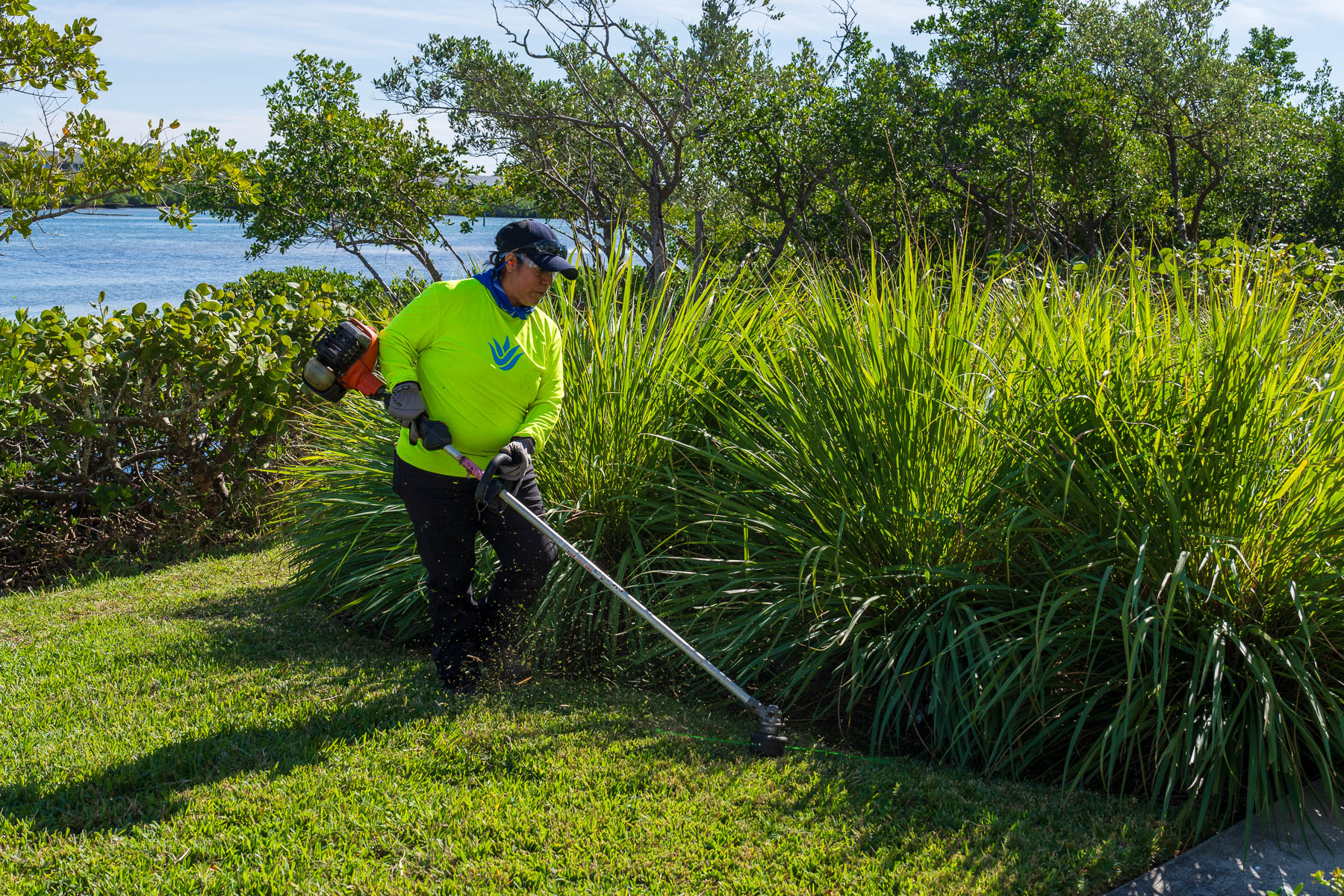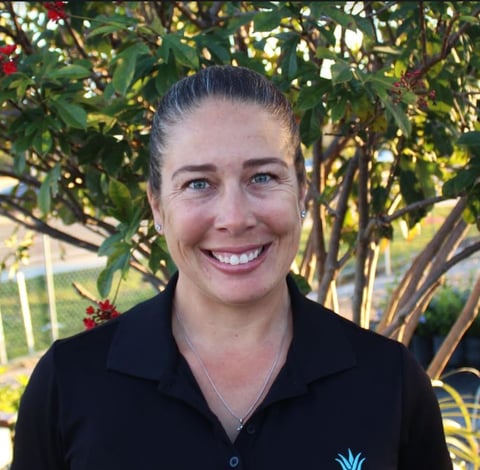
Low-Maintenance Landscaping Tips for Tampa Bay Homeowners
 Elizabeth Pelletier
Elizabeth Pelletier
Landscaping is a tricky business, especially in a state with a challenging climate, like our beloved Florida. If you’re craving a property with thoughtful landscaping that appears pristine year-round, you’re in for a never-ending battle against the forces of nature.
A phenomenal design and strategy to implement it go a long way, but they are merely the tip of the iceberg for Tampa Bay homeowners trying to create an oasis of a landscape that endures every season. Even in the Sunshine State, it is maintenance that matters most.
While some homeowners in Tampa Bay may have the passion to pour into their landscape endlessly (and the budget to back it up), the reality is it takes far more commitment and effort to maintain a landscape than most people realize, and accompanying that hard work is a hefty price tag.
Thankfully, we’ve used our over 20 years of experience landscaping in the Tampa Bay area to refine our process and discover more cost-effective ways of maintaining even the unruliest properties. Now, we’re bringing that knowledge to you, so you can enjoy a gorgeous environment without breaking the bank.
Low-Maintenance Landscaping Ideas & Tips for Homeowners in Tampa Bay
If you want to enjoy a beautiful Tampa Bay landscape without having to fret about over-the-top maintenance and sky-high landscaping bills, you’ve come to the right place. Florida is ripe with potential for low-maintenance, high-reward landscaping; you just need a little know-how and guidance to get there.
Regular Maintenance Results in Less Maintenance
This concept may seem contradictory at first but stick with us when we say that regular landscape maintenance translates to less maintenance. The top trick to enjoying a good-looking Tampa Bay property year-round is not infallible design or even clever plant selection (though both would help); it is routine maintenance performed by a professional landscaper.

Think of it this way. Tomorrow is the day you’ve fantasized about for years. You’ve saved up, done innumerable hours of research, and are finally ready to purchase your dream car. So, you go out and buy a top-of-the-line Ferrari.
Are you going to drive that work-of-art-on-wheels for 100,000 miles without ever handwashing it or having it serviced by a certified professional? Of course not! Failing to properly care for such a machine would be careless and almost certainly lead to one of the most impressive vehicles on the planet experiencing issues well before its time.
The same goes for your landscape. You undoubtedly have invested time, resources, and money into crafting a landscape that speaks to you and complements your property. Regular maintenance ensures that it continues to perform at peak levels for the foreseeable future. Failure to give your landscape the attention and care it deserves can lead to significant problems that are not only avoidable but terribly expensive and frustrating to correct.
The long story short is this—regular visits from a professional landscaping and gardening crew will ensure your property not only looks good all year but also remains healthy and (major) problem-free for as long as possible.
Utilize Proper Mowing Techniques
Mowing is one of the basics of landscape maintenance, but that doesn’t mean that it’s easy or that everyone gets it right. Not only is it surprisingly common for mowing to be done improperly, but the damage that can be done is also eye-opening. Mowing properly results in low-maintenance Florida landscaping.

There is enough information about mowing that we could dedicate an entire blog to it (who knows; maybe we will), so we’ll try to stick to the essentials here. The following checklist is a great place to start when evaluating whether you (or the company you work with) are using the right mowing techniques.
- Always use sharp blades. Dull blades create unsightly grass that is frayed at the tips and tends to brown, so sharpen your mower blades regularly.
- Mow at the right time. Mowing your lawn too early can be hard on your mower and make your property look like a mess due to the dew on the grass and its tendency to clump. Mid-day mowing and mowing after 6 pm (or so) is also not recommended, as the grass needs an opportunity to recover.
- Set your blades at the right height. The height at which your blade should be set will depend heavily on the variety of grass being cut. Different species will respond uniquely to mowing, and a professional landscaper should be able to identify the grass and adjust accordingly.
- Change your mowing pattern. It can be easy to fall into a rhythm when mowing, but it is vital to change your mowing pattern throughout the year. Executing the same pattern time after time is likely to cause browning and grooving (thanks to the repetitive crushing of a heavy mower), and the grass may actually start to adapt to or bend in the direction of the blades, making the process less effective. Changing your mowing pattern avoids these issues.
Invest in Irrigation for Your Landscape & Garden
Florida may receive its fair share of afternoon thunderstorms, but your property still needs proper irrigation if it is to thrive year-round. The heat, occasional droughts, and other environmental factors at play in the Sunshine State mean that maintaining a diverse landscape populated with a variety of plant types can be complicated and expensive.

Investing in an irrigation system—especially a modern smart irrigation system—can pay off in the long run. Not only do such systems account for climate factors (including the changing weather), but they also can deliver a precise amount of water directly to the root systems of plants that need it.
The result is healthier plants that require less maintenance. Irrigation also reduces the frequency with which you will need to replace plants that are either no longer thriving or have succumbed to Florida’s sometimes-ferocious landscaping environment. It may be a significant investment initially, but the long-term benefits of irrigation far outweigh the costs.
Find Low-Maintenance Landscape Success with Landcrafters
Having your cake and eating it, too, is entirely possible in the Tampa Bay area. With the right low-maintenance processes in place, you can enjoy year-round beauty without breaking the bank or pouring your resources into high-maintenance landscaping investments. It just takes a little planning, some integral knowledge, and a partnership with an experienced professional landscaper.
If you want more low-maintenance Florida landscaping ideas, like using native plants and being strategic with your mulching, we encourage you to check out our blog.
For those who are ready to take their Tampa Bay landscape to the next level, don’t hesitate to request a consultation. Our team of passionate landscaping experts is happy to help you every step of the way, from planning your property to maintaining it once it’s established!

Elizabeth Pelletier
Account Manager, Gardening for Landcrafters, Inc. Elizabeth Pelletier's roots are based in agriculture, having grown up on her family’s farm in rural southeast Alabama. Her nearly 22 years in the green industry began by managing Carol’s Nursery, a small nursery, greenhouse, and landscaping operation. With an undergrad and graduate studies in Horticulture from Auburn University, Elizabeth has published research in The Journal of Environmental Horticulture. Moving to Tampa Bay in 2020, Elizabeth quickly worked her way up to Account Manager at Landcrafters through dedication to production quality, communication, accountability, expertise, and passion for plants. Elizabeth holds GI-BMP and FNGLA’s Certified Horticulture Professional certificates and is nearing completion of becoming a GI-BMP Instructor and receiving her ISA Arborist Certification.

